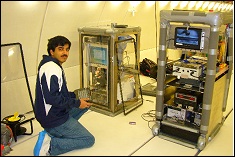News Story
Student, professor fly on ‘Vomit Comet’

ME graduate student Rishi Raj
Despite the frequent changes in gravity on the European Space Agency version of NASA’s “Vomit Comet” – changes that often cause stomach ailments among the flight’s passengers – graduate student Rishi Raj didn’t get sick. Raj and ME professor Jungho Kim traveled on the flight recently to study heat transfer at different gravity levels. German intern Martin Karch, from the University of Applied Sciences in Mannheim, Germany, also went on the flight.
Raj said NASA hopes to use the research in learning to boil water in space so the space agency can conserve costs on shipping water to space with the astronauts.
“You can have longer missions then, like Mars,” Raj said of the benefit of recycling the water.
The experiment took Raj and Dr. Kim to Bourdeaux, France, in March 2008 where they boarded three ESA flights in three days, with each flight making 30 parabolas over the Atlantic. The stomach-churning trips helped Raj and Kim collect data on heat transfer at different gravities, while also showing them the true meaning of weightlessness.
“It was really exciting,” Raj said. “When you study physics, you know what zero gravity is, but feeling it is something completely different.”
The flights gave the pair plenty of data to analyze as they continue to study heat transfer. Raj said they used n-perflourohexane, a liquid used for electronic cooling purposes. Each parabola on the flight gave them 10 seconds of data at high gravity and 30 seconds at low gravity. Raj and Dr. Kim will use the data collected to generalize on the ability to boil water at those gravities.
The eventual hope, Raj said, is developing the ability to recycle water in space to reduce NASA’s costs, making longer missions possible.
“Nobody has done this before,” Raj said. “NASA wants to plan missions to Mars and the moon, and they want to predict what will happen with the water.”
Published July 16, 2008









